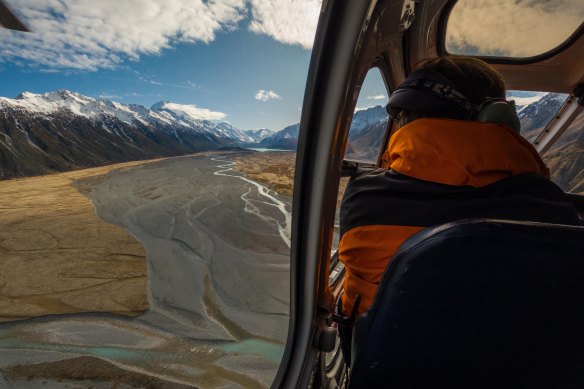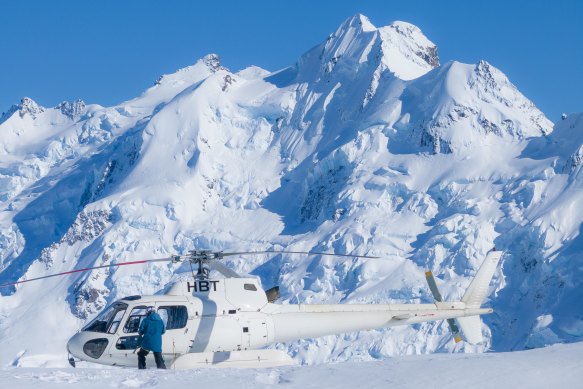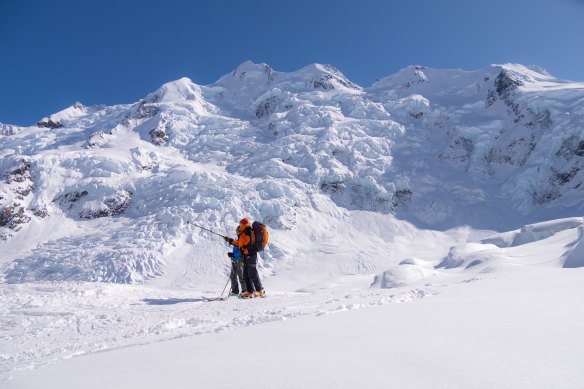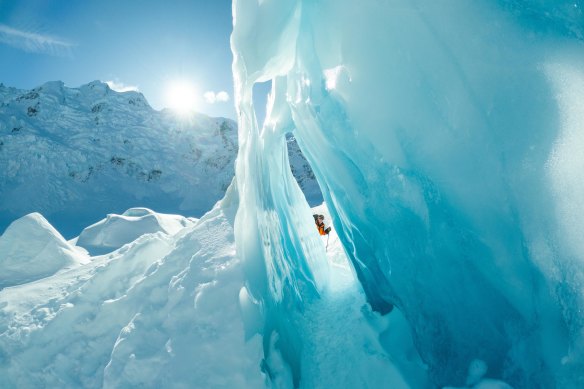This was published 1 year ago
One of the world’s most spectacular ski spots is surprisingly easy
By Jim Darby
It’s a crisp and sunny August morning at Aoraki/Mount Cook airport, and the scene is relaxed and efficient. The ground crew of one is wrangling helicopters from their hangers, towing them on trolleys with a four-wheel farm bike; the air-traffic controller is adjusting his high-vis vest and chatting in a friendly Irish accent; the pilots are doing their checks; and the mountain guides are handling their check-ins.
I’m here to ski the Tasman Glacier, that river of ice and snow pushing its way down between the soaring peaks of New Zealand’s Southern Alps. Few places offer such a spectacular alpine experience that demands such a modest skill level – on the Tasman, the skiing is mild but the environment is wild.
My guide, Sean Brooks, a lanky, softly spoken mountaineer from nearby Twizel, takes us through the safety checks and use of the avalanche rescue gear, and soon enough, we’re in the helicopter and in the air.

In the air and heading up to the Tasman Glacier.Credit: Kyle Mulinder/@barekiwi
We scoot over the gravel fields, land scrubbed flat by the glaciers, then make our way up the range, massive peaks unfolding nearby – Mount Tasman (3498 metres) comes into view and eventually Aoraki, “the cloud piercer” (3724 metres).
We land at the top of the glacier in an altogether different world. The sun is still shining, but it’s much colder up here, the snow light and fresh on the ground, diamonds of ice crystals floating through the air.

On the snow at the top of the glacier, the peaks of the NZ Southern Alps soaring above.Credit: Kyle Mulinder/@barekiwi
We’re right on the divide, gravity making a grab for the snow and ice on either side. Look west and the glaciers are flowing through the mountains and down to the Tasman Sea; look east, the way we came, and they’re making their way to Mackenzie Country, with its vast lakes and huge stretches of farmland.
Brooks points out what, to my eye, is just a line in the snow in the distance. “It’s a bergschrund,” he explains, “the crack that emerges between the moving ice of the glacier and the stable ice gripping the mountain.” The movement can create crevasses of unknowable depth. It’s good to have a guide in these parts.
Also in the group is Kyle Mulinder, otherwise known as @barekiwi, a photographer and videographer and one of a handful worldwide of official GoPro-anointed “gurus”. It’s a title he cringes at, but given his skill with that tiny video camera, it’s a status he doubtless deserves.
Mulinder has a permit to use a drone on the day and is forever apologetic for stopping and shooting. I try to explain the extent of the favour he’s doing me. The longer I can linger among these mountains, the better it is.
The skiing is smooth, and the terrain is gentle on the glacier’s wide-open snowfields. Bathed in sunshine and responding to the heat, the mountains are alive – grumbling, rumbling and crumbling with a rockfall here and an avalanche over there. This is the wonder of it – all this thunderous activity, close enough to be seen and heard but far, far from putting us in any danger.

Guide Sean Brooks pointing out the peaks with the ice of a hanging glacier in the background.Credit: Kyle Mulinder/@barekiwi
We roll on, skiing five or six kilometres down the glacier until Brooks leads us into an ice field, something like a living artwork – ice in every shade of blue wearing a cape of fresh white snow. We can ski through it in parts, weaving in and around icy towers and peering into ice caves.

A view through the ice.Credit: Kyle Mulinder/@barekiwi
Another kilometre or so down the glacier, Brooks makes a stop. “Might as well have lunch here,” he says. Why not? Aoraki is reaching into the sky above us, the hanging glaciers clinging to its side.
After lunch, the helicopter scoops us up and returns us to the top for a second run, more turns on the powder snow and another lap of the ice field. Then, a little lower, when the snow gets sketchy, we’re collected for the return flight, mountains alongside and the glacier below. And just like that, we’re back on the airstrip.
THE DETAILS
TOUR
Ski the Tasman operates from early July to late September, snow and weather permitting. The terrain doesn’t suit snowboarders but does suit skiers of intermediate level and above. The two-run days, including guiding, safety equipment, lunch and helicopter or ski plane transport on the glacier, cost $NZ1400 ($1285). See mtcookskiplanes.com
STAY
With views of Aoraki and easy (five-minute drive) access to the Mount Cook Airport, the Hermitage Hotel has rooms from $NZ295 ($270) or in its luxurious Aoraki Wing from $NZ555 ($510) a night. A package for the 2024 winter includes two nights at the Hermitage in a premium room, dinners and breakfasts and the Ski the Tasman experience, from $NZ4242 ($3895) for two people. See hermitage.co.nz
Jim Darby was a guest of Mt Cook Ski Planes and Mackenzie Region Tourism. See mackenzienz.com
Sign up for the Traveller Deals newsletter
Get exclusive travel deals delivered straight to your inbox. Sign up now.